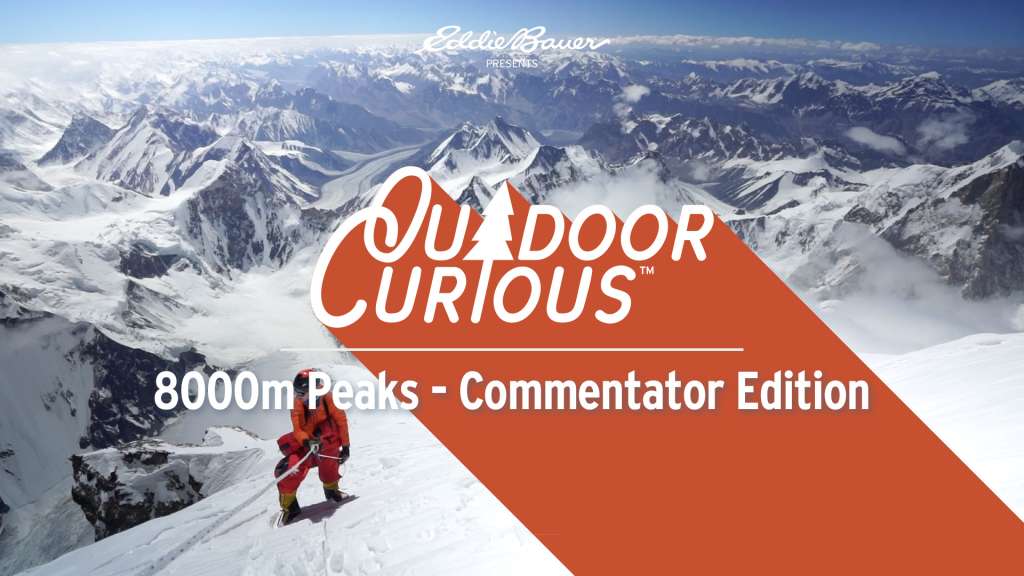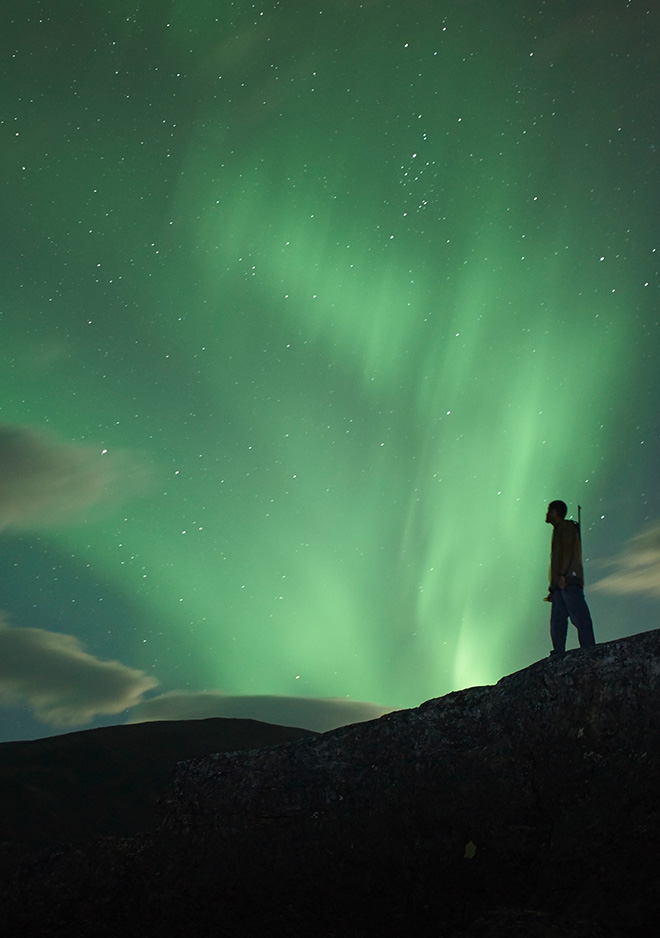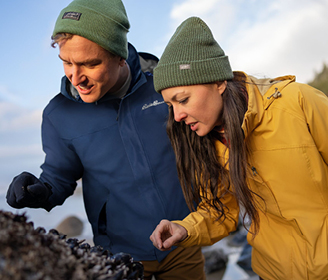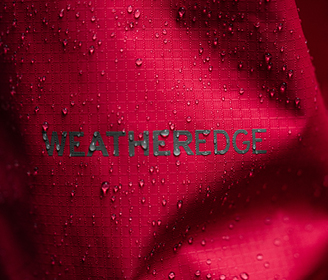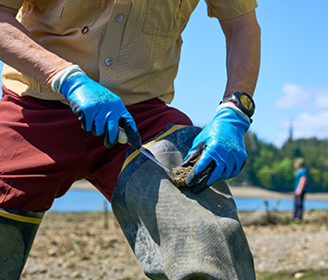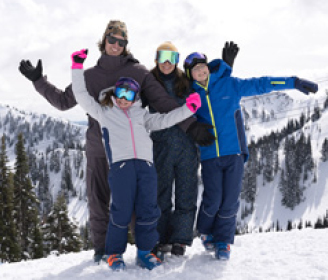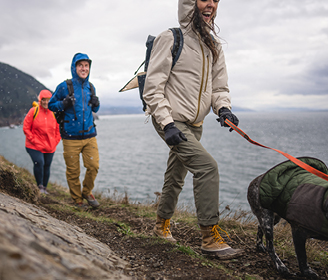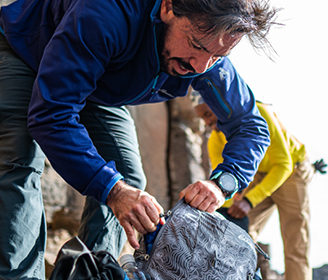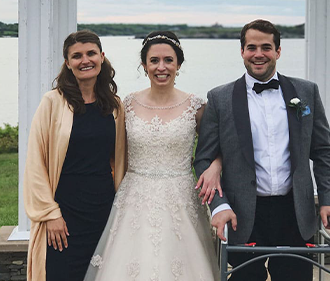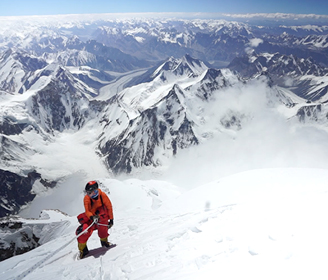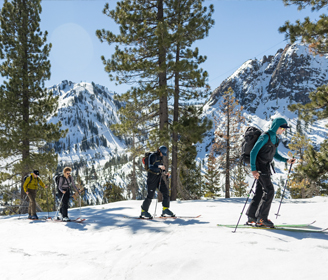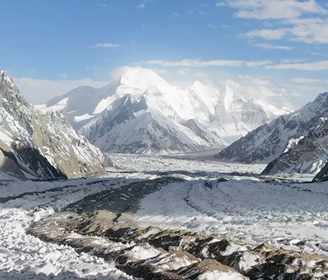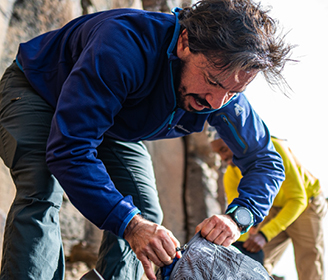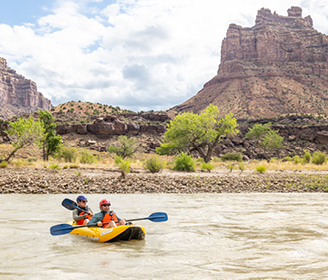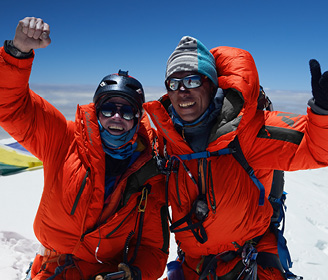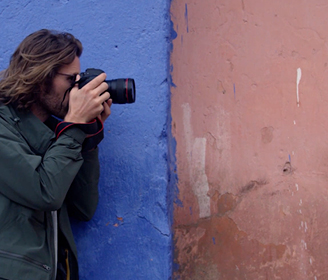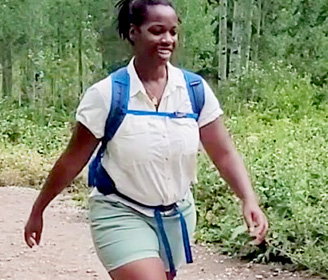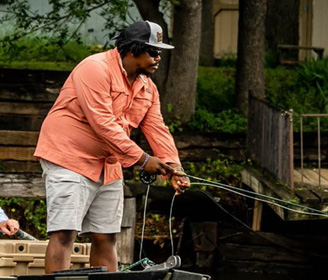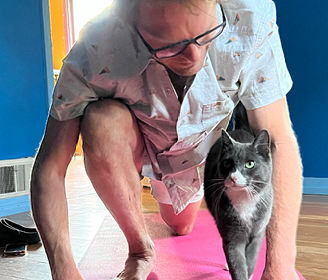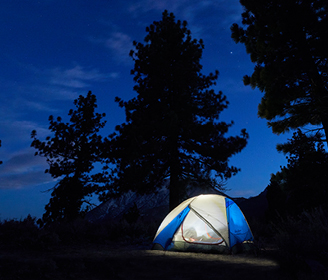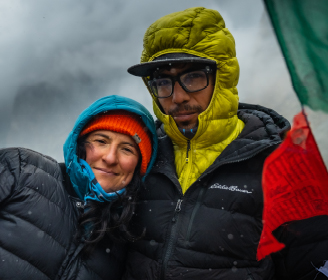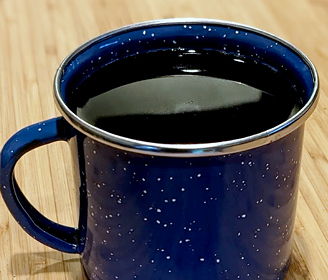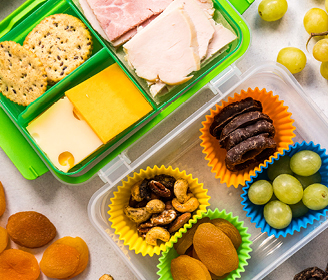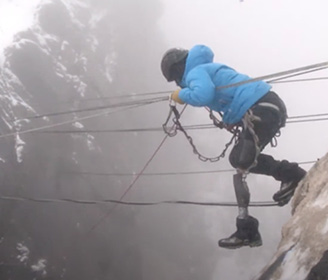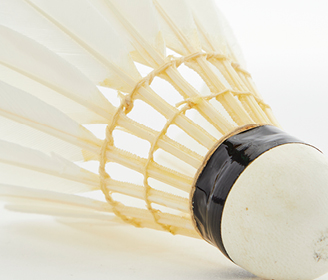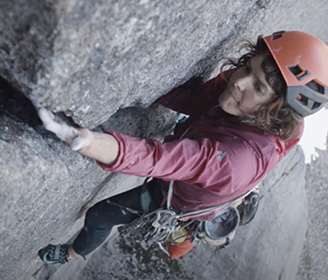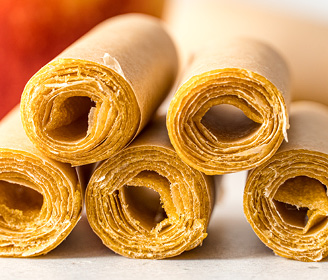You watched Adrian answer questions about 8,000 meter peaks in a previous episode of Outdoor Curious™. Now he’s back to answer your followup questions from the comment section in this “Commentator Edition” video. Do you want to know what daily life is like at basecamp? Who all is counted in summit data? How do you acclimatize your body? Find out in this part two episode.
00:31 – Thoughts on the difficulty level of Mount Cook.
This is a funny first question because it’s not an 8,000 meter peak, Mount Cook is a very technical famous and uniquely well respected mountain in New Zealand. It is very well respected as being a challenging mountain not only for its size and remoteness, but also especially for the terrible weather that it gets. So you’re climbing technical difficult terrain in very difficult weather conditions. Can’t wait to get there and check out Mount Cook one day.
01:06 – What is it like the first time you see an 8,000 meter peak in person?
My first time seeing Everest which was the first 8,000 meter peak I saw, was really really powerful. The funny thing is, if someone didn’t tell you it was an 8,000 meter peak, it probably wouldn’t look any different from a 7,000 meter peak or a 6,000 meter peak that you were just standing closer or further away from.
01:28 – Why do you try to make your body use more fat calories than carbohydrates? Since the fat decomposition uses extra molecules of O2 versus glucose, I know fat is more calorie dense, nine versus 4.7 kilo calories. Isn’t it better carrying more weight versus being less effective metabolism regarding oxygen use?
Nutrition is very individually based, one diet or food regimen that works for one climber might not work for someone else. And it really takes years of experience to figure out what works for your body. But there is a specific thing about fat versus carbohydrates at high altitude. And the reason for that is without supplemental oxygen, once we get really high, let’s say above 26,000 feet or in what people call the death zone, once we’re up that high, our digestive systems essentially shut down, the body decides that the digestive system is non-essential to life. It’s not as important as let’s say the cardio system or the pulmonary system or the brain, these things that have to keep operating. So the body shuts the oxygen that is available to your heart, your lungs, and your brain and turns off oxygen to things like your stomach. That means if you try to eat, you generally just feel really nauseous or possibly vomit back up what you put in when you’re in the death zone. And so for me, my body was very carbohydrate reliant but it meant I had to eat every 45 minutes or an hour, I’d have a shot block or a goo or an energy bar. And so that wasn’t really effective once I got above 26,000 feet without oxygen because my body just rejected those foods. The beauty of fat and fat-adaptation in athletes is we all have our fat stores already inside our bodies, we don’t have to put anything into our digestive system. The body can access calories we already have and keep on board, which is not possible with carbohydrates. We run through our carbohydrate or glucose stores really quickly. And by being a fat-adapted athlete, I didn’t need to put a lot of calories in, but could continue having energy to burn through those 43 hours.
03:27 – I’d like to ask Adrian, what daily life looks like in basecamp. How do you shower, how do you eat, how do you pass the time waiting to get ready for the ascent? Is there a hospital? What are the Sherpas there for? What are their different roles in tasks in camp? Do you drink alcohol? Is there fresh meat and vegetables there? How does communication between the camp work?
I guess my first suggestion would be if you’re interested in seeing what life is like in the big mountains and at basecamps at the bottom of mountains like Everest or K2, consider going on a basecamp track. With a company like mine, Alpenglow Expeditions, you’re invited to spend two or three nights at the basecamp with the climbing team after you do your track. So it’s an incredible way to get a taste without necessarily climbing a mountain. One of the best ways to give yourself the best shot up high is to be quite comfortable in basecamp. So Alpenglow Expeditions basecamps, we bring things like heaters and satellite internet and lights and games and good, healthy, fresh food and a really experienced local Nepali cook staff to support our expeditions and create those incredible meals. But it really does vary mountain to mountain. On Mount Everest, we climb on the Tibetan side of the mountain and we can actually drive all the way to basecamp at almost 18,000 feet. That means we can be incredibly comfortable there because we’re driving all our equipment in. Whereas the mountain we’re going to this season, Makalu the fifth tallest mountain in the world, that mountain’s very difficult to get to the basecamp and it’s in a really remote spot. So our basecamp is going to be still comfortable but much, much simpler. We think about every pound of equipment we bring there. But shower, we heat water in solar heaters and then put them into systems with little pumps that actually allow us to shower, takes a lot of sun and work to melt that water from snow or ice and then heat it. So most people don’t shower every day, they shower every few days. And then we use things like wet wipes or little bucket baths in our tent with just little bits of water from the kitchen to stay clean and healthy. Eating, again, we have this really incredible local team and we do get resupplies of fresh meat and vegetables through our expedition. So if the expedition is seven weeks long, imagine every two weeks we’ll have a yak train or a Porter train, or even occasionally a helicopter drop fresh meat and vegetables, which I think makes a huge difference to maintaining weight and strength through your summit push. There can be alcohol, we try to make basecamp feel like a place where people can relax. And once you’re fully acclimatized, even altitudes like 17 or 18,000 feet start to feel normal, almost like home. So a glass of wine with dinner, I’m an owner of a small wine company in California called Revelshine, where wine comes in aluminum recyclable bottles. That’s something we bring to basecamp and we might have a nice glass of wine with dinner, but obviously you need to be really careful about the dehydration properties of alcohol at altitude. And communication is something where I and my teams have invested a lot because we think communication saves lives. That means satellite communication out to the rest of the world, so we’re gonna get really high end weather forecasts in and really understand what’s gonna happen on the mountain on the days you’re writhing of climbing up high, it also means communication between Sherpa, guides, members and other teams. So when there are incidents or accidents or close calls up high on the mountain, we can have a lot of strength go to that accident wherever it is. So we use really strong, powerful walkie talkies up high on the mountain. We use something called inReach satellite communicators from a company called Garmin for texting, and then we have satellite phones and satellite wifi terminals for heavier use communications out away from the mountain. And I think good communications save lives and it’s something that if you are thinking of climbing an 8,000 meter peak, it’s something to really explore with your logistics operator or guide company. Have they invested deeply in communications?
07:33 – I climbed four flights of stairs at work today and was out of breath at the top. Why am I watching a question and answer about 8,000 meter peaks?
I get winded running upstairs at home as well. For me, climbing these big mountains, is all about picking a goal and it might be far out and then breaking that goal down into small steps with individual achievements or levels, goals that I reach, stepping stones that are much much smaller and far, far away from the mountain I’m trying to climb two years from now. I can’t just think about that goal that was years out, it was about the little stepping stones along the way and running up a flight of stairs might be one of those stepping stones.
08:13 – Why aren’t rebreathers used for high altitude? It does not matter if they leak. They don’t lose too much efficiency in the cold. The scrubbing chemicals weigh very little. Compared to scuba, they are simpler since you don’t have to worry about oxygen toxicity. It seems like a match made in heaven and yet there are no commercially available mountaineering rebreathing devices. Please give us your perspective on this, thanks.
I’m not a scientist and I am terrible with things like mechanical systems. The short piece that I do understand is what’s been found is the environments at extreme altitudes are so brutal and difficult on technology, on mechanical systems, so we need the absolute simplest system possible. Oxygen delivery systems traditionally at high altitude for climbing have just been very very simple bottle, continuous flow oxygen, very strong regulator that doesn’t fail, simple mask, this is what’s been found to just work and not break. There is more investment finally coming into auction systems for climbing. This has been such a tiny little world that no one’s really invested in systems for decades because it’s just not much commercial value potential profit for a company. Traditionally we’ve just used aircraft like fighter pilot systems. So originally we were using all Russian MiG oxygen systems, now there’s two companies out there that have innovated a little bit from that to make the systems lighter and more reliable at Summit Oxygen and TopOut Oxygen. And now I know of at least three very well respected people in the 8,000 meter community who are working with engineers to create a newer, lighter, yet reliable system using modern technology.
10:09 – Do you intend to climb all 14 of the 8,000 meter peaks, Adrian?
For those not familiar, 8,000 meter peaks are the highest peaks in the world. 8,000 meters equals approximately 26,000 feet and there are 14 mountains on the planet over 8,000 meters or 26,000 feet. They are all in Nepal, Tibet and Pakistan. I do not aspire to climb all 14, 8,000 meter peaks. I’ve never really been a list person I guess, like a checking the box list person, these mountains have a lot of risk in them and to climb all 14, 8,000 meter peaks, like many more climbers have died trying to climb all 14, 8,000 meter peaks without oxygen than have been successful. And I think it’s okay to take risk if you have a passion for it, and so I’m willing to take risk on big mountains, 8,000 meter peaks if they inspire me deeply inside and I don’t aspire to all 14, but there’s some other ones that still inspire me, and that’s why Makalu this spring.
11:11 – If Everest is so hard to climb, how can a 13 year old climb it?
First of all, respect the 13 year olds out there. Like, you know, I remember in the Summer Olympics seeing 13 year olds winning Olympic medals in doing incredibly difficult things. So I guess that’s my first answer that there are unique outliers on our planet in many different ways. And one of those ways can be a 13 year old that can do some of the hardest physical things on the planet. Climbing Mt. Everest, despite potentially being possible for someone as young as 13, has really high risks. And I think sometimes that gets lost and still we average, 10 to 15 fatalities a year on Mount Everest when 1,000 people, perhaps in a busy year are going to try to climb it. And that’s a high fatality rate that a lot of that death is unnecessary. It’s from poor decision-making or people having insufficient infrastructure behind them for when things go wrong.
12:23 – Does the number of people who climb Mount Everest include the people that really climb it to put the ropes up or is it only the people paying money as team members that are counted as summiteers?
This is a question I’ve seen a lot. No, any sort of database that counts the number of climbers on a mountain like Everest or Makalu or any 8,000 meter peak, that includes everyone who climbs the mountain. So we have clients or paying members, we have mountain guides, which could come from Nepal or announced certified mountain guides within the Sherpa community, but often mountain guides come from Europe, the United States, Ecuador, Peru, Argentina, really all around the world. We have a role on the mountain. And then we have Sherpa who are traditionally climbers from the areas around Mount Everest and they often do what I would consider like some of the hardest work on the mountain. Things like carrying the heaviest loads of oxygen and ropes and tents, setting up camps, potentially breaking trail, and sometimes rope fixing. But yeah, we’re all teammates on these big mountains and everyone’s counted in summit registers as they should be.
13:33 – Does being taller help climbing?
I think that really depends. My focus or my strength is in 8,000 meter peak climbing or very high altitude climbing, my body type is not the normal body type. I’m six foot two and weigh less than 140 pounds and that makes climbing these big mountains quite difficult because I struggle with cold so much. It probably wouldn’t be the choice body. A lot of the strongest climbers are kind of like shorter, stockier, a little heavier, really powerful. And I’m just like my nickname is stick bug, because little limbs, long legs. I think there is no body type that can, or can’t climb. We learn how to utilize our strengths and manage our weaknesses to be able to succeed at the goals and dreams that we have and to climb as best as we can.
14:25 – Is there a way to train your red blood cells properly if you don’t live at high altitudes?
Really the only way ultimately to create more red blood cells and to go through the physiological changes that allow the red blood cells to be as effective as possible at binding to oxygen, is to go to altitude. And so that’s why you hear that we do things like climb high, sleep low. We progressively increase our altitude, causing our bodies to kind of suffer because we’re not yet prepared for those altitudes, then we go back down to lower altitudes where our bodies are comfortable so that the signal we’ve given our body through hormones that it needs more red blood cells and more effectiveness in our oxygen carrying system, then we go back down low where the body can make changes, build more red blood cells, then we go back up high and do it again at the next higher altitude. And that’s why climbing any 8,000 meter peak takes weeks instead of just three or four days because we don’t go up and down just once, we go up and down and up and down and progressively going slightly higher each time. There are ways we can encourage that process while at home, physical fitness, first and foremost, second of all, there might be dietary things we can do and herbal supplements and medications we can use like acetazolamide and Diamox being the most effective one. We can also pre-acclimatize. So over the past decade I and my company, Alpenglow Expeditions, have developed a system of pre-acclimatization using hypoxic tents, essentially 10 that suck oxygen out of the air and add nitrogen, hypoxic tents have proven to be incredibly effective. The best example I can give for that is my Everest climbs with Alpenglow Expeditions used to be two and a half months long, and now they’re 30 days long. We’ve seen an increase in success rates, so summiting amongst our climbers and a decrease in safety issues and health issues at altitude, but it is in no way, a replacement for physical fitness training and gaining experience in the mountains to be able to make good decisions up high.
16:28 – Can you go to K2 but not climb it, just to see it? And another comment, I’ve always wanted to do this but I just wonder how much it would cost.
You do not need to climb the highest mountains in the world to experience joy from these incredible places. So yes, consider joining a team like with Alpenglow Expedition to experience a track through our basecamp. The only things I’d encourage is the same as if you’re thing of climbing a big mountain, do your research, find a company that’s well respected, that really considers safety of its members to be the highest priority. And second of all, that the ethics and sustainability of each of their decisions are being well thought out to make sure you are keeping these beautiful areas sacred for the next generation.
17:17 – Why haven’t you climbed Kangchenjunga?
So Kangchenjunga is the third tallest mountain in the world, just a little bit lower than Everest and K2. It’s a great question because it’s a mountain that does very much inspire me. It’s a dream to one day get there. I thought about going this spring, but decided that Makalu, this mountain I’ve failed on twice before, like pulled my heart strings a little bit more.
17:40 – Where does your accent come from?
I think I’ve been told this is actually the most popular question about me on the internet. I was actually born in England. My family’s from England, I was born in Chatham and lived there until I was six years old when my family moved for my dad’s job to Central Massachusetts. So if you can pick two strong accents in the world, probably a British accent from near Manchester and a Massachusetts accent from Wooster, they’re pretty notable. Somehow my two mixed together and this is what I’m left with.
18:18 – Has blood doping been tried to skip some of the acclimatization?
It’s impossible to imagine that people haven’t attempted to increase red blood cell counts through methods that are illegal in traditional sports. The reason I’ve heard from most professional athletes, other than ethics, we generally follow by choice, the ethics of Olympic sports or high end endurance sports like biking and trail running. So there is certainly an ethic in climbing that we should not be using medications, steroids, blood doping medicines in our sport, but it’s self enforced. We don’t get drug tested when we finish our climbs. Ours is a sport where style and purity is really, really important and we hold each other to that standard. From what I understand, of use of blood doping and things like that, athletes need to be very closely monitored by medical professionals because there’s just a lot of risk. It’s dangerous to do these things as well as illegal and in the high mountains where our health and wellness is so at risk already, adding another element, I think would be incredibly dangerous.
19:36 – Can I climb K2? I’m nine years old.
I don’t recommend climbing it at nine years old. One of body’s physiology, we haven’t even fully grown when we’re a young kid or a teenager, let your body fully grow. I think it takes a certain level of like maturity to make decisions around, am I ready to risk everything for this mountain? And do I understand how and when to make decisions around backing off a mountain and turning around if it’s too risky, because life is really important and there are so many things in this world, as important or more important to me than climbing big mountains. And I think that takes time to develop or at least it did for me. I wasn’t a great decision maker around risk in my teen years or even in my early 20s.
20:25 – Are you married? How do you deal with family?
Ah, this is great. I got married three months ago to my long time partner and girlfriend, Emily Harrington who’s also a professional climber. We’ve been together for 10 years. We actually met on Mount Everest in 2012 at 21,000 feet on the mountain. We met while doing a rescue for another climber and friend of ours. We discuss risk and passion really honestly and openly and often. And I think that’s the key to having a healthy relationship at the same time that I do a sport that has real risk and it takes me away from home for months of each year. I’m really lucky that Emily, my partner, has a similar passion and so she also takes a lot of risk in her sport, which is primarily high end rock climbing. We both understand the passion that we both have for these things and why it’s sometimes worth taking risk, but we also challenge each other for why we’re choosing these objectives whether they’re still worth it, how they’re worth it, who our teammates are, whether we’re going in with kind of clear, and pure heart and objectives. So that’s how we deal with it, it’s communication.
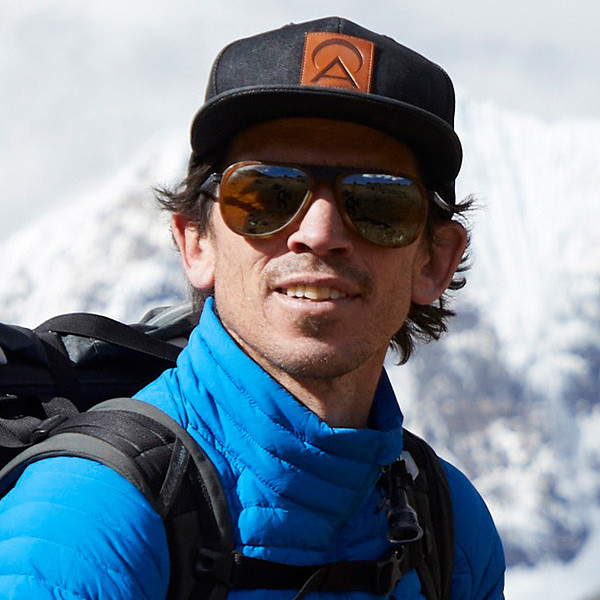
ADRIAN BALLINGER
Alpine Climbing Guide (AMGA/IFMGA)
In his two decades as a professional guide, Adrian has led more than a hundred clients to the summits of several 8000-meter peaks, including Everest, Lhotse, Manaslu, and Cho Oyu. He’s personally summited Everest eight times.

